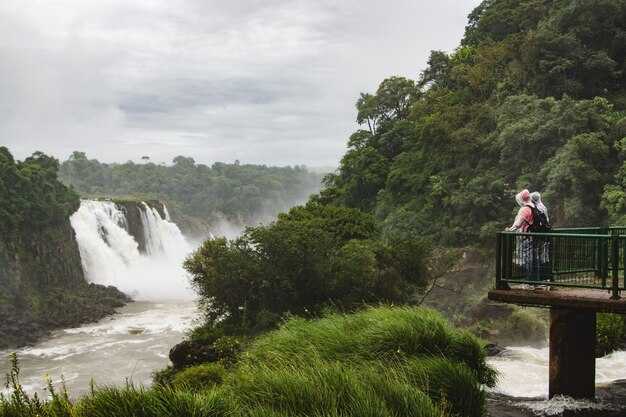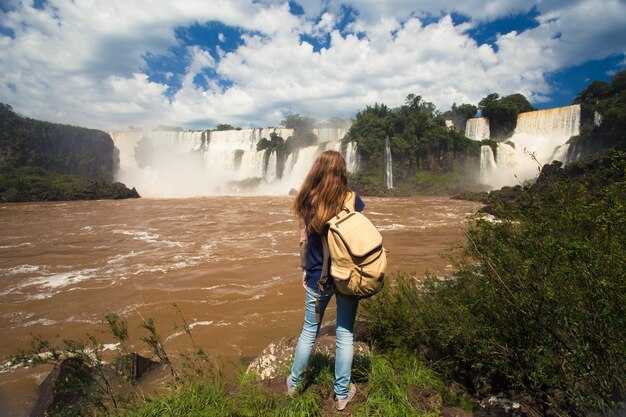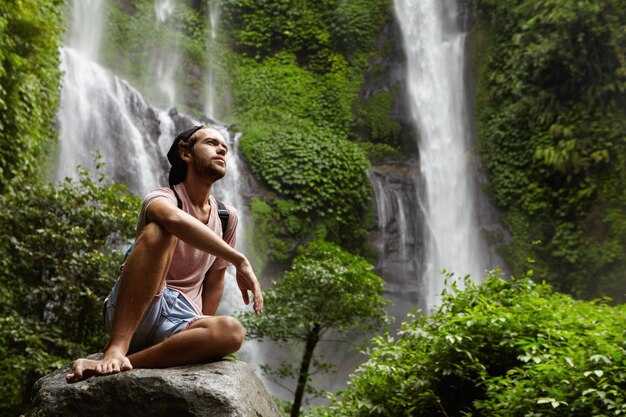advice: arrive before 9 am to enjoy cooler temperatures and clearer viewpoints on the Brazilian side. If you have arrived, head straight to the upper decks to catch the spray without long lines. Plan your route to maximize short walks between shaded spots and bring a light backpack with sunscreen and a microfiber towel.
Find your base: The belmond Hotel das Cataratas on the Brazilian side offers easy access to the park entry. If you lean toward budget options, frequent hostels around Foz do Iguaçu keep daily costs reasonable. michaela, an australian traveler, says a flexible plan and conversation with staff unlock quiet paths after rain. bring an amount for local taxis or shuttle buses, and reserve a couple of hours for a relaxed morning walk.
What to wear and pack: Wear sturdy shoes with grip for slippery stones. dont forget a lightweight rain jacket; the spray from the falls sticks to everything. Pack a compact poncho, bottled water, and a small power bank for photos. A daily plan helps you hit viewpoints in the best light, especially as temperatures rise.
Plan your route: Start at the main Brazilian circuit and work your way to the Garganta do Diabo overlook. Use the park shuttle to hop between trailheads, especially in peak heat. Look for wildlife, like toucans and coatis, along shaded stretches. A well-timed visit in the morning or late afternoon yields better lighting for photos.
Practical tips: Bring protection for cameras; the spray can fog lenses. dont rely on data connectivity in the park; download offline maps beforehand. The amount of walking is moderate but stairs add up; take breaks and hydrate. Consider a late-afternoon viewpoint, when temperatures drop again and mist creates rainbows.
Best Time to Visit the Brazilian Side for Garganta do Diabo Viewpoints
Plan your visit for May or September and start before 9 a.m. to catch Garganta do Diabo viewpoints on the Brazilian side with soft light and thinner crowds.
In these dry-season months, the wide catwalk stays dry, the air is comfortable, and visibility is best for photography. If you come in summer, be ready for higher humidity and occasional showers that heighten the mist and create dramatic portraits; the views remain powerful, especially in early morning light or late afternoon when the land and forest contrast most.
weve found that morning visits pay off: over the years, travelers have learned to optimize timing by starting early; weekdays are generally calmer; backpackers and local guests mix with day-trippers on weekends, but the quieter hours are still present. To simplify logistics, use rideshare from town to the park entrance, a reliable means to avoid parking hassles. On-site facilities provide a simple lunch option at the gate, but for a fuller meal you can purchase in town or at a nearby mall after your visit. wifi coverage is strongest near the main plaza; along the main catwalks it can be spotty, so download offline maps in advance. At the gate you obtain a map and can purchase tickets online to start smoothly. The Garganta route on the Brazilian side is wide and well-maintained, with viewpoints that place you between the spray and the forest land; some overlook on the opposite bank offer a different perspective if you plan a separate day trip to the Argentine side.
Timing and viewpoints
- Start early: aim for 7:00–9:00 a.m. to beat crowds and catch the best light.
- Prefer May or September for lower rainfall and comfortable temperatures, with strong water flow still present.
- Choose weekdays when possible; weekends draw backpackers and families, increasing crowding at key lookouts.
- Check the weather and park alerts the night before; morning mists can affect visibility if you start too late.
Practical planning

- Wear sturdy shoes for a wide, well-maintained path that remains mostly flat but can be slick after rain; plan for tiny spray droplets on skin and glasses.
- Pack light rain gear, sunscreen, and a small backpack; dorm-style hostels around town offer budget options if you’re traveling with a group.
- Purchase tickets online in advance to start your day smoothly; at the gate you can obtain a map and you’ll see coverage updates on-site.
- Use rideshare means to reach the entrance; it’s a common, cost-effective option for solo travelers and groups.
- Be mindful of wifi coverage: stay offline with maps if the signal is weak on the trails; download the route beforehand.
- Consider adding a second day to explore the Argentine side for a fuller variety of viewpoints between the two countries.
Getting There: From Foz do Iguaçu to the Brazilian Park Entrance
Book a private transfer or use a reliable taxi to reach the Brazilian Park Entrance quickly. From Foz do Iguaçu to the entrance, expect about 25–30 km of road, 30–45 minutes in light traffic; peak times can stretch it to 60 minutes. If you arrive via the IGU airport or other area airports, a pre-booked shuttle or taxi offers door-to-gate service, saving you stops and backtracking. Here’s a practical approach that keeps everyone on track.
Two solid ride options: private transfer or public bus
Option A: Private transfer. A driver waits in the arrivals hall at IGU or at your hotel and delivers you directly to the Park Entrance. Expect to pay around R$80–120 one way, depending on your hotel location and traffic; it’s better to pay a bit more for reliability, especially with kids or a lot of gear. If you’re traveling with others, the per-person cost drops and the space helps you pack everything you need. Passengers appreciate the convenience after travel, and the driver can stop for a quick photo along the road if you ask.
Option B: City bus. From downtown Foz, Bus 120 Cataratas runs roughly every 30–40 minutes and stops at the park gate. The ride takes about 60–75 minutes and costs around R$5–7. Board at the Terminal de Ônibus or at major urban stops; you’ll avoid parking hassles but share the ride with other passengers. If you missed the first bus, there are later departures–check the current timetable at your hotel or the terminal; plan to arrive early to beat the heat and crowds. Instead, if you’re on a tight budget, this is a better choice for the day.
There, crossing to the argentinean side is optional but can be a good complement in a full day. If you decide to cross, bring your passport and be prepared for customs checks; plan a separate entry and exit window, and note that afternoon temperatures can rise a few Fahrenheit degrees. If you want to explore ciudad neighborhoods on the other side, do it after you finish here and return for the Brazilian gates.
Practical packing and planning: pack light, leave bulky bags at the hotel if possible, and carry a small water bottle; the weather on the Brazilian side is sunny most days. In summer, temperatures often peak in the 80s or 90s Fahrenheit, so sunscreen, a hat, and a light jacket for cooler mornings help. The entry plaza is a short walk from the bus stop, but you’ll do more walking inside the park beyond the gate. Here, the shortest walk from the gate to the main outlooks takes about 15–25 minutes. If you’re touring with kids, pace yourself and add rests; everyone benefits from a relaxed rhythm. Create a simple itinerary list to guide your day, then review it at the bus stop to learn about current conditions and time windows, and leave some buffer for unexpected stops with others who share tips and plans.
Finally, a quick note to add to your plan: begin at the entrance, buy tickets, and consider the electric train for faster access to the most famous viewpoints on the Brazilian side. The vistas are amazing, and mornings offer softer light for photos. If you want a special day that blends park scenery with city culture, this route is worth the effort. The plan is straightforward, practical, and designed for smooth travel; by following these steps, you’ll avoid delays and enjoy the falls with less stress.
Ticketing, Parking, and Entrance Logistics for Garganta do Diabo
Purchase tickets online in advance and select an earlier time slot to make the visit easier and to avoid crowded queues during peak months.
Ticketing options on the official site include single-entry passes and combination experiences. Price varies by age and country of residence, with exchange rates available at checkout. The site accepts cards and cash, and the counter at the entrance can process exchanges for nearby networks if necessary.
Parking near the entrance is limited. Lot A sits closest to the Brazil-side entry, while Lot B is about a kilometre away along a walkable path. Expect hourly rates, with payment possible at the booth or via a mobile app. Plan for 1–2 hours if you want to explore both circuits and the lookout points without rushing.
Entrance logistics place you at a controlled gateway for Garganta do Diabo. Gates open early and close in the late afternoon; bring only essential belongings to speed checks, as staff conduct standard security inspections. Have your requirements ready–photo IDs, tickets, and any permitted tech–while keeping belongings compact to avoid intrusive lines. Use the main walkway and circuit route to reach the famous lookout without backtracking.
Local guidance from avid visitors adds value: Silva, a guide from Barroso, suggests starting at the lower circuit lookout to catch the best light, then following the walkways along the main circuit. The route is walkable for most guests, with a comfortable kilometre-scale stretch between lookouts. After the falls, many travelers enjoy a relaxed dinner nearby before departing for the airports or hotels in the country.
| Categorie | Recommendation | Opmerkingen |
| Ticketing | Book online; choose morning slot; print or save on phone | Price varies by country and age; exchange available at counter |
| Parking | Use Lot A near entry; Lot B is a short kilometre walk | Pay hourly; app or gate; plan 1–2 hours |
| Entrance | Arrive early; carry only essentials | Security checks are standard; lookouts along the walkway |
| Tips | Bring water, wear walkable shoes, consider a dinner stop after | Avid photographers will appreciate early light; Silva recommends route via lower circuit |
The Main Trail: Distances, Prime Viewpoints, and Walking Time to Devil’s Throat
Start at the entrance and walk directly toward Garganta do Diabo; this one-way segment conveniently sets you up for the final platform and definitely feels efficient for most visitors.
Het hoofdpad naar de Duivelskeel is ongeveer 2 km lang enkele reis, waarbij een comfortabel tempo in de buitenlucht ongeveer 40-50 minuten lopen oplevert. Als je van plan bent om bij elk uitkijkpunt te vertoeven en veel foto's te maken, reken dan 60-90 minuten voor de volledige nadering van het laatste platform.
Belangrijkste gezichtspunten en het wandelbereik
Na ongeveer 0,7–0,9 km biedt het eerste uitkijkpunt een breed zicht op de lagere watervallen en de nevel die bij helder licht regenbogen veroorzaakt. Nog eens 0,5–0,6 km verder brengt je naar een platform halverwege de route met een breder panorama over de rivier en de beboste oevers.
Het laatste platform van de Garganta do Diabo komt aan bij ongeveer de 2 km-markering en biedt het hoogste, meest opwindende close-up van de hoefijzervormige waterval. Dit is het lange, dramatische moment dat iedereen fotografeert, met nevel in de wind en een dramatische schaal waardoor de rest van het pad de moeite waard lijkt.
Langs de route vindt u zitplaatsen en schaduwrijke plekken om uit te rusten, waardoor de wandeling comfortabeler is voor families en iedereen die rekening houdt met hitte of zon. Voor mobiliteitsbehoeften kunt u bij het bezoekerscentrum terecht voor informatie over toegang tot de bovenste terrassen met behulp van een lift; sommige gedeelten bieden toegang via een hellingbaan of alternatieve routes naar het hoofddek.
Of je 's ochtends of 's middags op bezoek komt, schaduw en zitplaatsen helpen je om een gestaag tempo aan te houden. Vanaf de uitkijkpunten zie je de rivier zich wijd uitstrekken naar het noordwesten en de omliggende jungle, waarbij tijdens rustigere uren waarnemingen van wilde dieren mogelijk zijn. Zoek naar borden in het Spaans en Portugees die afstanden aangeven en houd de kaarten bij de hand voor een gedetailleerd plan van je specifieke haltes. Als je je energiek voelt, wordt elk uitkijkpunt een buitenactiviteit, waardoor het pad zelf een compacte excursie wordt.
Dit plan kun je aanpassen aan je eigen tempo en interesses. Als je in de buurt verblijft, bieden de nabijgelegen restaurants snelle hapjes voor of na de wandeling; als je weinig tijd hebt, kun je de route inkorten door na het eerste of tweede uitkijkpunt terug te keren en toch de belangrijkste hoogtepunten te zien.
Wat te dragen en wat in te pakken voor wandelingen in het regenwoud
Begin met sneldrogende broeken of shorts en een ademende, waterdichte jas; draag stevige, gesloten schoenen met goede grip. Als je een fietstransfer of een korte rit tussen locaties plant, kies dan schoenen met een goede pasvorm en neem handschoenen mee.
Lagen helpen: een vochtafvoerende basislaag, een lichte tussenlaag en een compacte regenjas. Wat je draagt, hangt af van de voorspelling en je tolerantie voor vochtigheid; 's ochtends is het koeler en kan de temperatuur snel stijgen op grotere hoogten. Regen kan snel opkomen, dus wees voorbereid.
Wat in te pakken
Neem vanaf de ingang een dagrugzak van 8-12 liter mee met een waterdichte zak voor elektronica. Pak een drinkfles of hydratatiesysteem in; streef naar minstens 1,5 liter voor een wandeling van 60-90 minuten.
Zonbescherming: hoed, zonnebril, zonnebrandcrème. Insectenbescherming: insectenwerend middel. Bescherming tegen regen: poncho of lichtgewicht regenjas als je rugzak geen hoes heeft.
Waterdichte hoes voor een telefoon of camera; reservebatterijen; een snackreep voor energie.
thermen zijn vlakbij, dus neem een handdoek mee als er een plan is om na de wandeling thermen te bezoeken.
Neem contant geld in peso mee voor grenspunten; de meeste aankopen in het park accepteren kaarten, maar sommige kraampjes zijn afhankelijk van contant geld. Voor accommodatie en maaltijden zijn er hotels en restaurants in de buurt; plan dienovereenkomstig.
Nationale en internationale bezoekers kunnen buiten de ingang transfers en taxi's regelen; de openingstijden variëren per seizoen. De meeste rondleidingen duren 60-90 minuten; er zijn drukke dagen, dus plan extra minuten in voor fotoplekken en uitzichtpunten.
Fotografietips: de Iguazu-watervallen vastleggen aan de Braziliaanse kant
Ga bij het eerste licht naar de porto-regio voor heldere nevel en warm licht op het salto-platform; houd een snelle lens gereed en veeg regelmatig vocht van uw filter om scherpe randen op de mist te behouden. Ontwikkel fotografoe gewoontes: controleer het licht om de paar minuten en scan de scene voordat u aan de slag gaat, zodat u geen vluchtige regenboog mist.
Aan de Braziliaanse kant zijn de paden beperkt in kijkhoeken, dus plan een circuit van 60-90 minuten om de belangrijkste uitkijkpunten en de paden door de binnenste boomkruin te bekijken. Controleer de actuele openingstijden en vertrektijden van het park om uw schema af te stemmen op rustigere momenten; datum en weer bepalen de reflecties, en de algemene omstandigheden kunnen snel veranderen. Als u missiereizen combineert, coördineer dan zorgvuldig, maar blijf flexibel om hinderlijke drukte te vermijden. Gebruik dit als basis voor het plannen van uw route om het zonlicht op elk uitzicht te maximaliseren.
In het park kunnen drukte opdringerig zijn in de buurt van de belangrijkste platformen; probeer net na een sproeibeurt te fotograferen en stap dan de weelderige randen in voor intieme beelden dicht bij het water. Wees bedachtzaam op de wilde dieren langs de randen, inclusief katten. Parkeren is handig in de buurt van de ingang, maar ga terug voordat de drukte van de pendeldienst piekt; u zult verrassend stille hoeken hebben gevonden langs zijpaden, en u zult blij zijn dat u comfortabel schoeisel draagt om uw voeten te beschermen.
Beste tijden en uitkijkpunten
Prime light vindt plaats na zonsopgang; vanaf het Salto-uitkijkpunt vang je een regenboog op als de zon klimt. Vanaf sommige uitkijkpunten zie je enorme vergezichten van het watergordijn, en dan verschuif je langs de promenade om de watervallen in te kaderen terwijl de nevel door het bos trekt. Voor extreem dramatische silhouetten, blijf hangen tot laat in de ochtend en opnieuw laat in de middag wanneer schaduwen zich uitstrekken langs de waterval. Overweeg een tweede doorgang op de binnenste lus om waterlinten door de bomen vast te leggen. Kies over het algemeen een paar belangrijke plekken en gebruik een lichtgewicht statief om wiebelen op de promenade te voorkomen, terwijl je altijd ruimte overlaat om de veranderende nevel te volgen.
Uitrusting, instellingen en planning

Gebruik een groothoeklens (16-35 mm) voor panorama's en een mid-telelens (70-200 mm) voor close-updetails van de watervallen en nevelige aura's. Stel de belichting in rond f/8-f/11 en ISO 100-200; voor zijdezacht water, probeer 1-2 seconden met een stevig statief, of schakel over op snellere sluitertijden als de wind de nevel verplaatst. Een polarisatiefilter helpt schittering op heldere dagen te verminderen, en een grijsfilter verlengt je lange belichtingstijden. Maak foto's in RAW en gebruik apps om routes in kaart te brengen, parkeergelegenheid te controleren en datum-/tijdvensters en vertrektijden bij te houden. Als je in de buurt verblijft, is een tijdspanne van 2-3 uur geschikt voor een ontspannen tempo; voor gezinsvriendelijke uitstapjes, houd de segmenten kort en sta een extra luxe verblijf in de buurt toe. Als je misiones-reizen combineert, vind je meer landschap en minder wachttijden. Eindig met een snelle voetencheck: stap achteruit om de schaal te bepalen en je apparatuur te beschermen tegen opspattend water.



Reacties